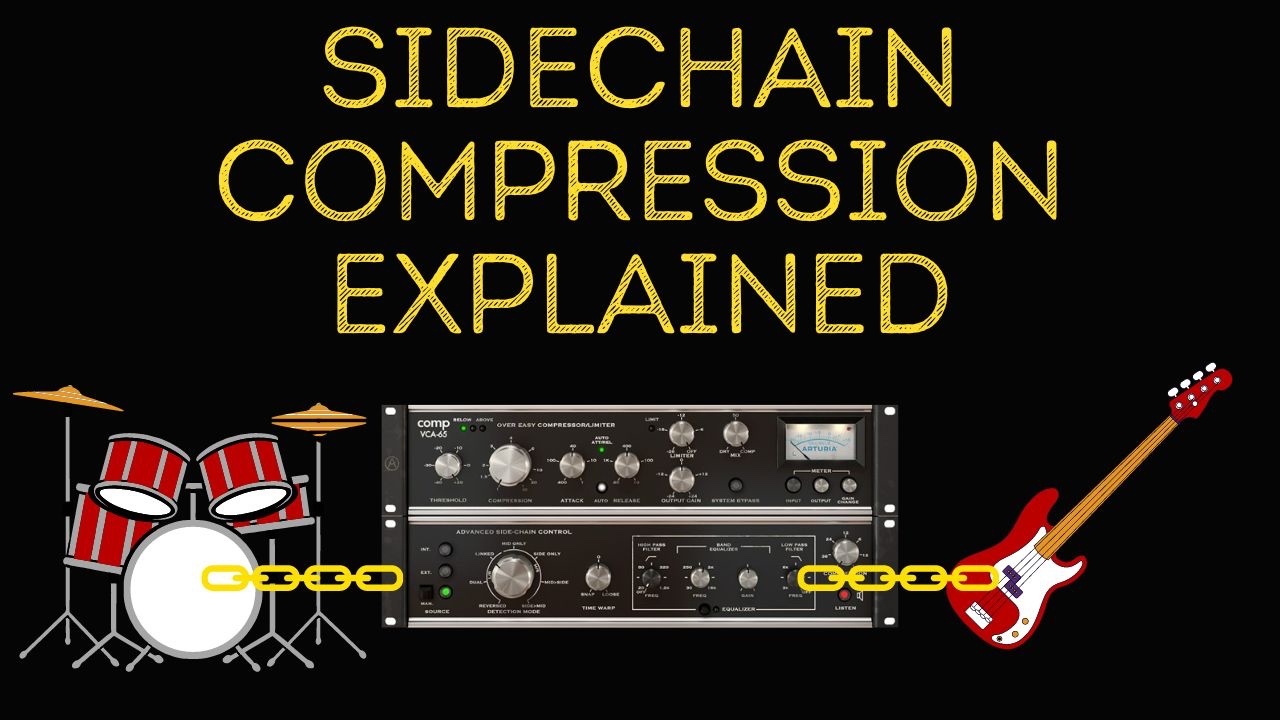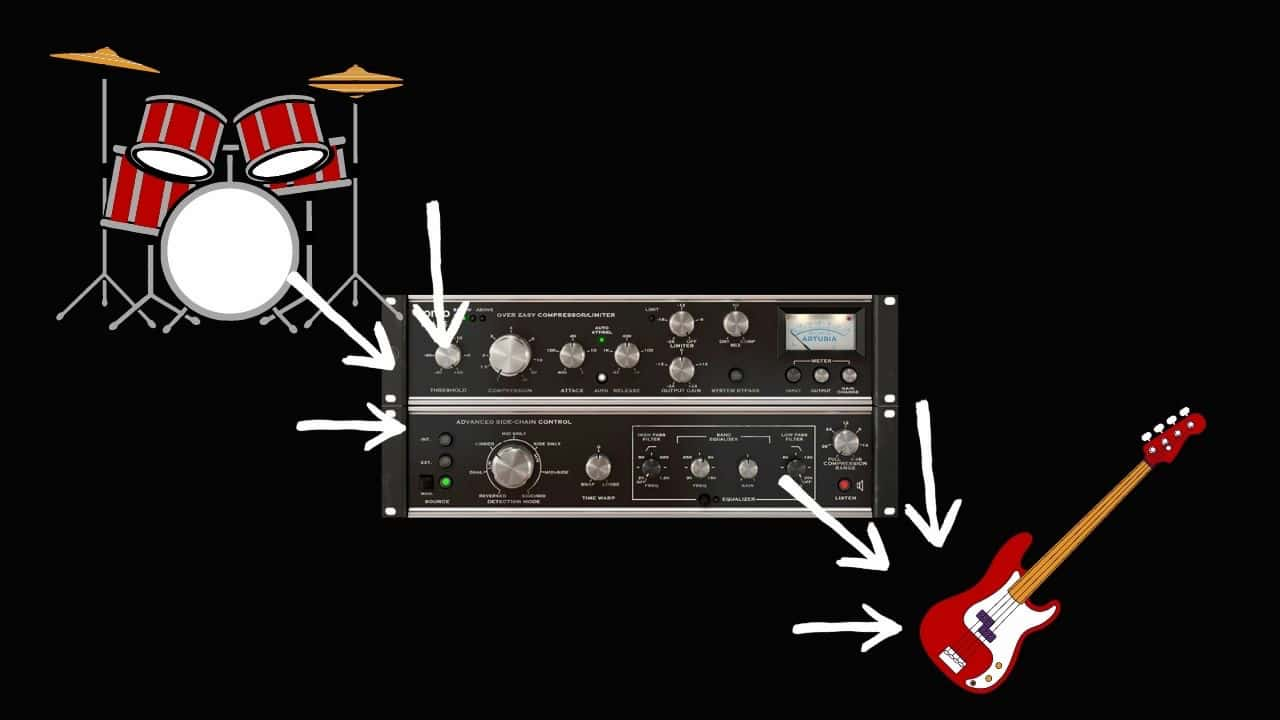Sidechain Compression

Sidechain compression can be one of the most powerful tools in your music production toolkit. It's extremely versatile, and can be used to create distinctive rhythms, increase the perceived volume of drums and create extra space in your mix. So let's look at how you can use sidechain compression to improve your music!
What Does Sidechain Compression Do?
Sidechain compression is when one instrument’s level triggers a compressor so that it reacts to another. The trick became popular in EDM as it allowed producers to craft large dense mixes with kicks that popped through.

You can think of a sidechain as the boss of a compressor. It tells the compressor how to react to a signal. Normally, if you put a compressor on a bass the compressor will turn the bass down whenever the bass is loud. But if you sidechain the kick drum to the bass compressor, the compressor will turn the bass down whenever the kick is loud.
The first use of sidechain compression was in the voiceover world. It was invented by Douglas Shearer so that the dialogue of an actor would get quieter if the actor said something ultra-sibilant.
Sidechain Compression Examples
Sidechain compression is used in many modern mixes, though sometimes it is so subtle that you can’t actually hear it.
In the EDM world, sidechain compression has become somewhat of a production effect. One random example is “Are You Lonely” by EDM overlord Steve Aoki. You can hear this pumping effect during the drops, adding rhythm to the song.
Sidechain compression is just as popular in the radio world. Listen to the hosts on NPR. Every time they speak, the music or background noise behind them will get quieter. This is a form of sidechain compression too - and one you should definitely consider using in mixing. For example, if you feel like your lead vocal is getting lost in the mix, you could sidechain the vocals to the guitar, so that the guitar turns down a couple of dB when the vocals are singing. This allows the vocals to cut through while maintaining a solid wall of guitar tone.
Another example is to sidechain the vocals to the vocal reverb. That way, when the singer is singing, the reverb is quiet, which will result in clean, less muddy vocals. But then when the singer stops sing, the sidechain compression will be inactive allowing the reverb to turn up on the final notes of a phrase with a pleasant tail that elongates the vocal sustain.
Sidechain Compression Settings
Setting up the sidechain compression link is going to be different in every piece of recording software, and may even depend on the specific compressor you're using. Given the variability, we won't talk here about how to assign a sidechain source. But if you want to know the specifics, I'd recommend going to YouTube and search for "How to sidechain in X DAW."
Sidechain compression settings will vary based on the song and your needs. Generally, however, I find myself using a fast attack and fast release for sidechain compression if my goal is to limit masking, as this will duck the offending instrument or signal right away to make room for the more important element.
A ratio of 5:1 should do the trick.
On the other hand, if my goal is to use sidechain compression to impart an exciting rhythmic element on the track, I’ll try to time the release to the tempo of the song.
Is Sidechain Compression Necessary?
Sidechain compression is not necessary by any means. However, it can be a very valuable tool to learn for modern mixing. Whether you’re trying to create an innovative rhythm using a sidechain in your production or simply allowing instruments to fit within the same space without masking one another, sidechain compression can be a super helpful tool.
Learn more about Mixing with Compression
This is only one part of mixing with compression! Luckily, I've put together a bunch more articles to help you master this crucial mixing skill!
- How to Use a Compressor: Learn to Mix with Compression Quickly!
- Sidechain Compression Explained for Beginners & Key Settings
- 3 Tips for Using a Sidechain Compressor to Add Punch & Clarity
- Multi-band Compression Tutorial for Great Vocals, Drums & More!
- How to Use Mid-Side Compression for Amazing Recordings!
- How to Use Parallel Compression for Powerfully Punchy Mixes
- Should You Compress Reverb? The Real Answer Finally Revealed.
- The 5 Types of Compressors (And Exactly When To Use Each)
- 10 Vocal Compression Mixing Tips (Including Best Settings)
- 9 Powerful Drum Compression Techniques for Punchy Pro Mixes
- Loud, Punchy Kick Drums with these Compression Settings
- How to Compress Snare - Use *These* Settings Punchy Snares
- Exactly How to Compress Bass for Tight Low End Thump!
- How Compress Acoustic Guitar Perfectly, Every time
- How to Compress Synthesizers: Best Compressor Settings for Synths
- How to Compress Organ: 4 Steps to a Great Mix!
- How to Compress Percussion: Compression Settings for Everything
- How to Compress Strings: 8 Magic Settings You Need to Know
From a Frustrated Producer in a Ragtag Bedroom Studio to Major Placements on TV Earning $1,000s!
My name is Evan, and I've been making music since around 3rd grade. I'm from San Diego, California, but I've lived in Washington, DC for the last 20 years.
While I still have a full-time day job, I have created systems that have allowed me to produce dozens of songs a year in my spare time.
My songs have been on Netflix, TV shows like the 90 Day Fiance, an award-winning indie film, and NPR’s “All Thing Considered.” They've also been streamed millions of times.
In addition to being a music producer, I am passionate about teaching people how they can make professional-sounding music and earn money licensing it, all in their spare time.
Thousands of musicians, like yourself, have trusted me to guide their musical journey. My YouTube videos have been watched nearly a million times. And my story has been in Forbes, Side Hustle Nation, and the Side Hustle School.





